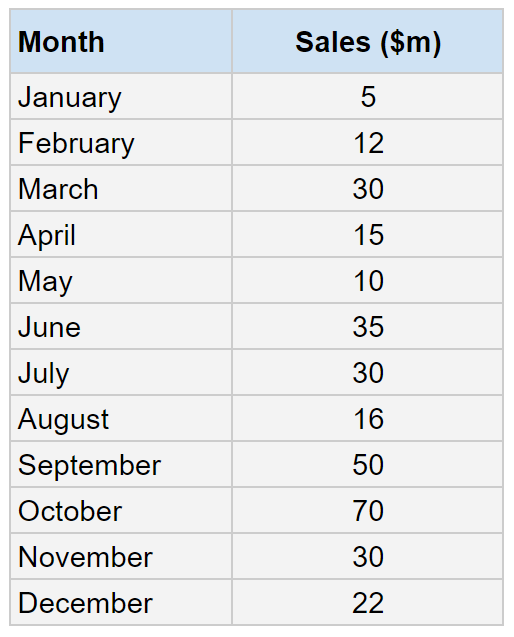Unit 4.3 Business Management
Unit 4.3 Sales Forecasting (HL)
Someone is getting fired!
The CEO of Link (a Chinese car company) has asked for reliable predictions (forecasts of future sales)! The CEO wants accurate data to smooth out problems of interdependence between departments! Without knowing accurately what demand will be, the production department cannot order and plan effectively!
Complaints have been that not enough materials are ordered through the purchasing department for production or that components arrive too late! Another complaint has been the success of a recent marketing campaign has led to, too many enquiries about Link cars and not enough sales department staff to field and reply to customers!
The sales team and market research team tried various techniques to predict future sales but haven’t got it quite right yet!
First of all, extrapolation was tried, but the numbers were too high! Secondly, market research was tried, but it was too expensive and didn’t account for rapid changes in price or sentiment towards the brand! The third and final technique used to predict sales got closest to accurate forecasts! This was, ‘time series analysis‘.


Someone is getting fired!
The Chinese EV market has been heavily subsidized by the government, which has attracted a range of new players (competitors) into the market. Whilst this has been great for consumers, competition between manufacturers has intensified! Each manufacturer now is engaged in lowering costs, lowering prices and high volumes of advertising in an attempt to increase unit sales of cars! This growth is wanted so companies can take advantage of economies of scale and reduce their costs per unit (car)
Link car company has noticed that there is large variation in sales, though there does seem to be general improvement. The seasonal variation that was expected did not materialise; that sales would drop in Winter. There is expected to be some shrinking in sales volumes after January as the economy is said to be slowing (cyclical variation).
On the right is the sales data for the first year of trading for Link car company. To keep your job, you are tasked with providing the most accurate forecasts of future data possible. You will use, 3 and 4 point moving averages and examine the underlying trends.
Unit 4.3 Sales Forecasting: Information overview
Sales:
- Overview: Sales represent the financial transactions involving goods or services exchanged for money.
- Example: Apple’s iPhone sales contribute significantly to its revenue, showcasing the importance of product sales in a business model.
Trends:
- Overview: Trends denote long-term shifts in consumer behavior, industry practices, or market conditions.
- Example: The rise of e-commerce reflects a trend where consumers increasingly prefer online shopping over traditional retail.
- Overview: Forecasting involves estimating future sales, aiding in strategic planning and decision-making.
- Example: Amazon’s data-driven forecasting algorithms optimize inventory management, reducing the likelihood of stockouts or excess inventory.
Sales forecasting offers several advantages.
It helps organizations anticipate future demand, enabling better inventory management and production planning.
This, in turn, minimizes excess inventory or stockouts, optimizing resource utilization.
Additionally, sales forecasting aids in budgeting and financial planning, providing a basis for setting realistic revenue goals.
It enhances decision-making by offering insights into market trends and potential challenges.
Ultimately, effective sales forecasting contributes to the overall efficiency and strategic planning of a business.
Uncertainty: Future is unpredictable, and external factors such as economic changes can impact forecasts.
Over-reliance: Blind reliance on forecasts without considering dynamic market conditions may lead to inaccurate predictions.
Time and Cost: Developing and maintaining sophisticated forecasting systems can be time-consuming and expensive.
Human Factor: Forecasts may be influenced by individual biases, affecting the accuracy of predictions.
BUT, most notably……things change! Exogenous (external) factors change unpredictably! Inflation, trends, sentiment, GDP, inflation and tax (to name just a few). These changes can completely invalidate sales forecasting!
QUESTIONS: SOMEONE IS GETTING FIRED
- Calculate the mean, mode and median of the sales dats from Link car company [3]
- Define the term sales forecasting [2]
- Define the term extrapolation [2]
- Define the term interdependence [2]
- Explain how market research might try to predict sales trends [2]
- Identify two examples of interdependence at Link car company [2]
- Explain how sales might vary according to Link car company’s position in the product lifecycle (PLC) using the diagram from above [4]
- Explain how Link car company may be benefiting from a government subsidy [2]
- Explain how a car manufacturer (like Link) could benefit from economies of scale [4]
- Plot the sales data (from the data above) for Link car company [4]
- Calculate the 3- month moving average (from the data above) for Link Car Company [4]
- Calculate the 4-month moving average (from the data above) for Link Car Company [4]
- Explain two benefits of sales forecasting [4]
- Explain (with reference to Link car company) the difference between seasonal and cyclical variations [4]
SUGGESTED ANSWERS TO...
1 Calculate the mean, mode and median of the sales date from Link car company [3]
See data table below
2 Define the term sales forecasting [2]
- Definition: Sales forecasting involves estimating future sales of a product or service based on historical data, market analysis, and relevant factors. It is a crucial aspect of business planning and management, providing insights into potential demand and helping in resource allocation.
- Importance: Sales forecasting aids in decision-making, budgeting, inventory management, and overall strategic planning. It allows businesses to anticipate market trends, set realistic goals, and adapt their strategies accordingly.
- Methods: Businesses use various methods for sales forecasting, including quantitative approaches (such as time series analysis and statistical models) and qualitative approaches (involving expert judgment and market research).
3 Define the term extrapolation [2]
Definition: Extrapolation is a statistical method used to estimate or project future values based on extending or projecting past trends. It involves assuming that the established trend will continue into the future.
Importance: Extrapolation is commonly used in sales forecasting, financial planning, and trend analysis. It provides a simple way to make predictions about future outcomes by linearly extending existing data patterns.
Example: If a company has observed a consistent 5% increase in sales each quarter, extrapolation would involve projecting that trend forward to predict future sales, assuming the same growth rate continues.
Extrapolation is a tool that businesses use to make reasonable estimates about future performance, but it comes with the assumption that the past trend will persist, which may not always be accurate in a dynamic business environment.
4 Define the term interdependence [2]
Definition: Interdependence refers to the mutual reliance and connection between different parts or components within a system. In a business context, it often relates to the interconnectedness of various functions or departments where the actions of one part impact, or are impacted by, the actions of another.
Importance: Understanding interdependence is crucial for effective organizational management as it highlights the need for coordination and collaboration between different elements to achieve common goals.
Example: In a manufacturing company, there is interdependence between production and logistics. Changes in production schedules affect the demand for logistics services, and efficient coordination is essential for smooth operations.
5 Explain how market research might try to predict sales trends [2]
Market research might seek to examine attitudes within the market. A survey (primary research) could seek to obtain some indication of how many people within a certain population size or sample size might be interested in purchasing a new EV car. The results of this survey could then be used to predict numbers from a wider population.
6 Identify two examples of interdependence at Link car company [2]
Firstly, purchasing fail to order enough components which impacts upon the production department!
Secondly, marketing are so successful that they generate more interest than can be dealt with by the sales team!
7 Explain how sales might vary according to Link car company’s position in the product lifecycle (PLC) [4]
Define the product life cycle, show (by drawing) a diagram of its four parts (introduction, growth, maturity and decline). Explain that sales are dictated by position on this chart, with lower sales at the introduction phase and highest sales at the growth stages. Currently, it looks like sales are in an upward trend after the introductory phase. Perhaps link car company is in the growth phase (or soon to be)!
8 Explain how Link car company may be benefiting from a government subsidy [2]
A subsidy is an amount of money given to a company (such as Link) to encourage production and to bring prices down. Link can invest this into production, invest in new technologies or research and development for future models. This allows link to receive money to develop, but also to receive income from the customer from sales. In short, it is another source of income, which can only be beneficial.
9 Explain how a car manufacturer could benefit from economies of scale [4]
A car manufacturer can benefit from economies of scale in several ways:
Lower Average Costs: As production levels increase, the average cost per unit decreases. This is because fixed costs, such as factory setup and equipment, are spread over a larger number of units. For instance, the cost of designing and setting up the production line is divided among a greater number of cars, reducing the cost per car.
Bulk Purchasing Discounts: Higher production volumes allow the car manufacturer to negotiate better deals with suppliers due to the increased quantity of materials and components purchased. This results in lower per-unit costs for raw materials and parts.
Operational Efficiency: Larger production runs enable the manufacturer to optimize its processes and achieve operational efficiency. This includes streamlining production lines, reducing waste, and improving overall productivity, contributing to cost savings.
Investment in Technology: Economies of scale provide the financial capacity for a car manufacturer to invest in advanced technologies and innovations. This could lead to more efficient production methods, enhanced product quality, and the development of new features, giving the manufacturer a competitive edge.
In summary, economies of scale empower a car manufacturer to reduce per-unit costs, negotiate favorable terms with suppliers, enhance operational efficiency, and invest in technological advancements, ultimately improving its competitiveness and profitability.
10 Plot the sales data for Link car company [4]
See data table below
11 Calculate the 3- month average for Link Car Company [4]
See data table below
12 Calculate the 4-month moving average for Link Car Company [4]
See data table below
13 Explain two benefits of sales forecasting [4]
Sales forecasting offers several advantages.
It helps organizations anticipate future demand, enabling better inventory management and production planning.
This, in turn, minimizes excess inventory or stockouts, optimizing resource utilization.
Additionally, sales forecasting aids in budgeting and financial planning, providing a basis for setting realistic revenue goals.
It enhances decision-making by offering insights into market trends and potential challenges.
Ultimately, effective sales forecasting contributes to the overall efficiency and strategic planning of a business.
14 Explain with reference to Link car company, the difference between seasonal and cyclical variations [4]
- Nature: Seasonal variations are regular and predictable fluctuations in data that occur at specific times of the year. These patterns often repeat annually.
- Cause: Seasonal variations are primarily driven by external factors such as weather, holidays, or cultural events that influence consumer behavior.
- Example: Retail businesses often experience higher sales during holiday seasons like Christmas or back-to-school periods.
- Nature: Cyclical variations are repetitive fluctuations in data that occur over an extended period, but the patterns are less predictable and don’t have a fixed time frame.
- Cause: Cyclical variations are often linked to economic cycles, with periods of expansion and contraction impacting various industries and business activities.
- Example: During economic recessions, consumer spending tends to decrease, affecting industries like luxury goods and travel.
Distinguishing Factors:
- Predictability: Seasonal variations are more predictable as they follow a regular pattern, while cyclical variations are less predictable and depend on broader economic conditions.
- Timeframe: Seasonal variations have a fixed timeframe, repeating annually or at specific intervals, while cyclical variations can occur over several years and don’t follow a fixed schedule.
- External Influence: Seasonal variations are often influenced by external events like holidays, weather, or cultural practices. Cyclical variations, on the other hand, are tied to broader economic factors.
Understanding the distinction between seasonal and cyclical variations is crucial for businesses to make informed decisions and adapt their strategies to different types of fluctuations in demand and economic conditions.








